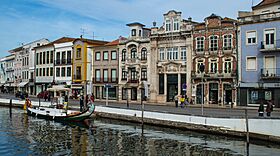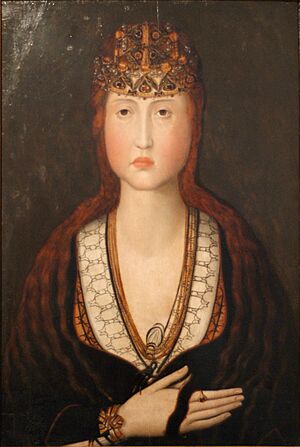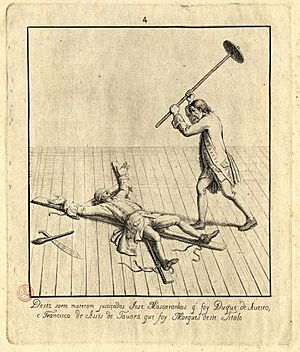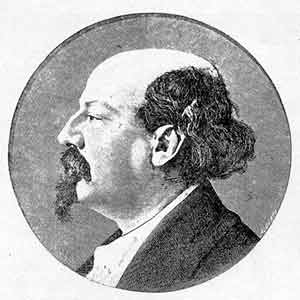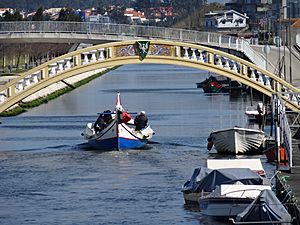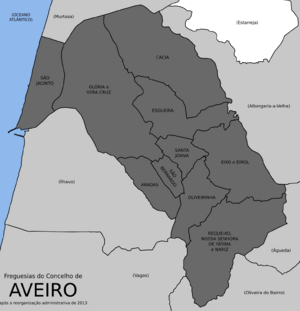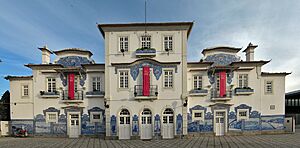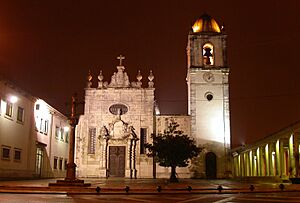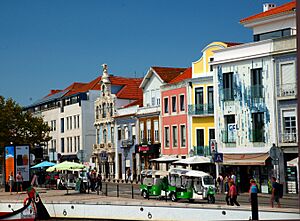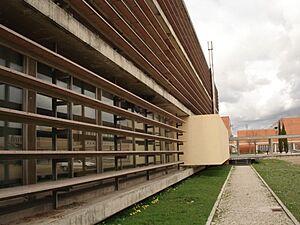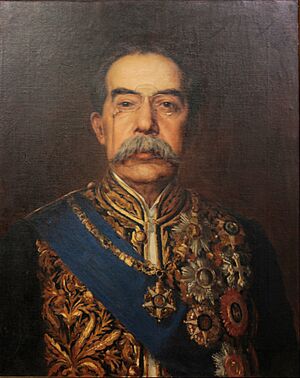Aveiro, Portugal facts for kids
Quick facts for kids
Aveiro
|
|||
|---|---|---|---|
|
Municipality
|
|||
|
Ilha dos Puxadoiros, Moliceiro Boat, Moliceiro travel, Old Capitania do Porto, Set of Salt Warehouses on the São Roque Channel or Salt Palheiros on the São Roque Channel, Town Square
|
|||
|
|||
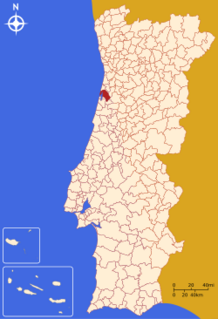 |
|||
| Country | |||
| Region | Centro | ||
| Intermunic. comm. | Região de Aveiro | ||
| District | Aveiro | ||
| Parishes | 10 | ||
| Area | |||
| • Total | 197.58 km2 (76.29 sq mi) | ||
| Population
(2021)
|
|||
| • Total | 80,880 | ||
| • Density | 409.35/km2 (1,060.22/sq mi) | ||
| Time zone | WET/WEST (UTC+0/+1) | ||
| Local holiday | 12 May | ||
Aveiro is a city and a municipality in Portugal. In 2021, about 80,880 people lived there. It covers an area of 197.58 square kilometers (about 76.29 square miles). Aveiro is the second largest city in the Centro Region of Portugal, after Coimbra.
Together with the nearby city of Ílhavo, Aveiro forms a larger urban area with about 120,000 people. This makes it one of the most important populated areas in the North Region. The city is led by José Ribau Esteves, who was chosen by a group of political parties. Aveiro is divided into ten smaller areas called civil parishes.
Contents
History of Aveiro
People have lived in the Aveiro area since ancient times, even before recorded history. The name ‘'Averius'’ comes from an old Celtic word, aber, which means "river-mouth."
For a long time, Aveiro was very important for making salt and for trading by sea. The Romans used to get salt from here. It was also a busy trade center during the Middle Ages. Records show it existed as early as January 26, 959. An old document from that time called the area "a gathering place or preserve of birds and of great salt."
From the 11th century onwards, Aveiro became a favorite place for Portuguese kings and queens.
Royal Connections
King João I wanted strong walls built around Aveiro. His son, Pedro, who was in charge of Aveiro, suggested this.
In 1435, King D. Duarte allowed Aveiro to have a special yearly fair. This fair was called the Feira de Março (March Fair), and it's still a tradition today!
Princess St. Joana, who was the daughter of King Afonso V, lived in Aveiro. She joined the convent of Jesus and stayed there until she passed away on May 12, 1490. Her presence brought a lot of attention to the town and helped it grow and develop.
Aveiro received its first official document, called a charter, from King Manuel I of Portugal on August 4, 1515. Its location by the Aveiro River always helped it thrive through salt production, fishing, and sea trade.
By the early 15th century, a large wall already surrounded the historic center. This showed how important and growing the community was. Many religious buildings were also built, which helped the town during tough times in the 17th and 18th centuries. These problems were caused by the river mouth getting blocked by sand. In 1575, a big storm closed the port entrance, stopping trade and creating a sand barrier to the Atlantic Ocean. The old walls were later taken down and used to build new docks.
Between the 16th and 17th centuries, the river's entrance to the ocean became unstable and closed off. This made the water in the lagoon (a shallow body of water) become still. This was a big problem for the economy, causing a crisis and making many people leave Aveiro. During this time, the Church of the Miserícordia was built.
In 1759, King José I made Aveiro a city. This happened a few months after he ordered the death of Duke José Mascarenhas of Aveiro. Because of this, Aveiro was briefly called Nova Bragança, but it later went back to its original name. In 1774, a new church area, called a Diocese, was created in Aveiro.
In the 19th century, people from Aveiro were active in the Liberal Wars. A man named José Estêvão Coelho de Magalhães, who was a member of parliament, was very important. He helped solve the problem of getting boats through the Ria (the lagoon system). He also helped develop transportation, especially the railway line between Lisbon and Porto. The opening of new artificial canals in 1808 allowed Aveiro to grow economically, marking the start of the town's modern development.
The municipality became a town, centered around its main church, which was dedicated to the Archangel Michael. This church was later taken down in 1835, and its location is now the Praça da República (Republic Square).
Geography of Aveiro
Aveiro is located on the coast of the Atlantic Ocean. It is an industrial city with an important seaport.
The main part of the municipality is the city of Aveiro itself. It includes five urban parishes with about 73,003 people. Aveiro is also the capital of the Aveiro District. It is the largest city in the Baixo Vouga region.
Aveiro is often called "the Portuguese Venice" because it has many canals and boats, much like the famous Italian city of Venice.
Climate in Aveiro
Aveiro has a warm-summer Mediterranean climate. This means it has hot, dry summers and mild, wet winters. Its location near the Atlantic Ocean makes the temperatures more moderate. Summers average around 24°C (75°F) during the day, which is cooler than places further inland. Frosts are very rare and never severe. The hottest temperature ever recorded was 39.3°C (102.7°F). Temperatures above 32°C (90°F) do not happen very often.
| Climate data for Aveiro, 1981-2010 | |||||||||||||
|---|---|---|---|---|---|---|---|---|---|---|---|---|---|
| Month | Jan | Feb | Mar | Apr | May | Jun | Jul | Aug | Sep | Oct | Nov | Dec | Year |
| Record high °C (°F) | 21.5 (70.7) |
25.0 (77.0) |
28.9 (84.0) |
32.5 (90.5) |
39.0 (102.2) |
37.6 (99.7) |
39.3 (102.7) |
38.1 (100.6) |
35.1 (95.2) |
33.5 (92.3) |
26.0 (78.8) |
24.0 (75.2) |
39.3 (102.7) |
| Mean daily maximum °C (°F) | 14.4 (57.9) |
15.4 (59.7) |
17.5 (63.5) |
18.2 (64.8) |
20.2 (68.4) |
22.8 (73.0) |
24.0 (75.2) |
24.4 (75.9) |
23.7 (74.7) |
21.1 (70.0) |
17.4 (63.3) |
15.2 (59.4) |
19.5 (67.1) |
| Daily mean °C (°F) | 10.4 (50.7) |
11.4 (52.5) |
13.3 (55.9) |
14.3 (57.7) |
16.3 (61.3) |
18.9 (66.0) |
20.1 (68.2) |
20.4 (68.7) |
19.5 (67.1) |
17.1 (62.8) |
13.6 (56.5) |
11.5 (52.7) |
15.5 (59.9) |
| Mean daily minimum °C (°F) | 6.3 (43.3) |
7.3 (45.1) |
9.1 (48.4) |
10.3 (50.5) |
12.5 (54.5) |
15.0 (59.0) |
16.1 (61.0) |
16.2 (61.2) |
15.2 (59.4) |
13.0 (55.4) |
9.8 (49.6) |
7.8 (46.0) |
11.5 (52.7) |
| Record low °C (°F) | −3.0 (26.6) |
−2.5 (27.5) |
0.0 (32.0) |
1.5 (34.7) |
5.5 (41.9) |
8.5 (47.3) |
11.4 (52.5) |
10.0 (50.0) |
8.5 (47.3) |
3.5 (38.3) |
1.0 (33.8) |
−3.0 (26.6) |
−3.0 (26.6) |
| Average precipitation mm (inches) | 119.8 (4.72) |
87.5 (3.44) |
67.2 (2.65) |
91.2 (3.59) |
74.9 (2.95) |
29.3 (1.15) |
13.5 (0.53) |
19.7 (0.78) |
49.3 (1.94) |
128.8 (5.07) |
128.3 (5.05) |
134.5 (5.30) |
944.0 (37.17) |
| Source: Instituto Português do Mar e da Atmosfera | |||||||||||||
Population and Parishes
The population of Aveiro has grown a lot over the years. Here's how it has changed:
| Population of Aveiro Municipality (1801 – 2021) | |||||||||
|---|---|---|---|---|---|---|---|---|---|
| 1801 | 1849 | 1900 | 1930 | 1960 | 1981 | 1991 | 2001 | 2008 | 2021 |
| 14 144 | 10 780 | 24 919 | 31 644 | 46 055 | 60 284 | 66 444 | 73 335 | 73 100 | 80 880 |
The municipality of Aveiro is divided into 10 civil parishes (small local areas):
- Aradas
- Cacia
- Eixo e Eirol
- Esgueira
- Glória e Vera Cruz (This is the main urban center where the city government is located)
- Oliveirinha
- Requeixo, Nossa Senhora de Fátima e Nariz
- Santa Joana
- São Bernardo
- São Jacinto
São Jacinto is on a peninsula, a piece of land almost surrounded by water, between the Atlantic Ocean and the Ria de Aveiro.
International Connections
Aveiro has "sister cities" around the world. This means they have special friendly relationships. Here are some of them:
 – Arcachon, France, since 1989
– Arcachon, France, since 1989 – Belém, Brazil, since 1970
– Belém, Brazil, since 1970 – Bourges, France, since 1989
– Bourges, France, since 1989 – Cholargos, Greece, since 2001
– Cholargos, Greece, since 2001 – Ciudad Rodrigo, Spain, since 1989
– Ciudad Rodrigo, Spain, since 1989 – Cubatão, Brazil, since 1992
– Cubatão, Brazil, since 1992 – Farim, Guinea-Bissau, since 1992
– Farim, Guinea-Bissau, since 1992 – Forlì, Italy, since 1990
– Forlì, Italy, since 1990 – Inhambane, Mozambique, since 1989
– Inhambane, Mozambique, since 1989 – Mahdia, Tunisia, since 1998
– Mahdia, Tunisia, since 1998 – Ōita, Japan, since 1978
– Ōita, Japan, since 1978 – Panyu District, China since 2000
– Panyu District, China since 2000 – Pelotas, Brazil, since 1996
– Pelotas, Brazil, since 1996 – Pemba, Mozambique, since 1995
– Pemba, Mozambique, since 1995 – Santa Cruz, Cape Verde, since 1993
– Santa Cruz, Cape Verde, since 1993 – Santo António, São Tomé and Príncipe, since 1998
– Santo António, São Tomé and Príncipe, since 1998 – Trois-Rivières, Canada, since 1996
– Trois-Rivières, Canada, since 1996 – Viana do Castelo, Portugal, since 1910
– Viana do Castelo, Portugal, since 1910
Economy of Aveiro
For many years, Aveiro was famous for making salt. It was also known for harvesting moliço seagrass, which was used as fertilizer. The special boats used for harvesting now take tourists on the canals. Salt production has greatly decreased, and only a few salt ponds remain.
Today, the region is known for its many ceramics industries. This shows a long history of making pottery, going back to Roman and early Medieval times.
Software development is also important in Aveiro. There is a research center for a large telecom company and the University of Aveiro. The university has 15,000 students and works with companies on research projects.
The city has several shopping centers and malls, like Fórum Aveiro and Glicínias Plaza. Fórum Aveiro is very central and has clothing stores, restaurants, and book shops.
Tourism in Aveiro
Tourism is a big part of Aveiro's economy. The old city center has beautiful Art Nouveau and Romanesque buildings. The "gondolas" (called barcos moliceiros) that once collected seaweed now carry tourists along the canals of the Ria de Aveiro. This is why Aveiro is sometimes called "The Venice of Portugal."
Some important places to visit include:
- The Arte Nova (Art Nouveau) buildings with their unique designs and tiles from the early 20th century.
- The Art Nouveau museum.
- The Aveiro Museum (formerly the Mosteiro de Jesus convent), which has exhibits about King Afonso V's daughter, Santa Joana.
- The 15th-century Aveiro Sé or São Domingos cathedral.
- The Church of Jesus (Igreja de Jesus) with its interesting architecture.
The nearby beaches, Costa Nova and Barra, are very popular in warm weather. You can reach them by bus from Aveiro. Other places of interest are the Carmelite Church and the Misericórdia Church, both built in the 16th century.
Transportation in Aveiro
Aveiro has good transport links that help its economy.
Air Travel
For air travel, there is the Aeródromo de Aveiro/São Jacinto.
Rail Travel
Train services include fast trains like Alfa Pendular (connecting Lisbon to Braga and Porto, and Faro to Porto) and Intercity trains (connecting Lisbon to Porto and Guimarães). There are also local suburban trains and a narrow-gauge railway line called the Linha do Vouga to Águeda and Sernada do Vouga.
Road Travel
Major highways like the A1 (between Porto and Lisbon) and the A25 (linking Viseu, Guarda and Vilar Formoso) connect Aveiro to other cities. Intercity buses also run between Aveiro, Porto, and Lisbon many times a day.
Water Travel
The traditional Moliceiros boats are used for tourist trips along the Ria. They are also used for fishing and recreation.
Architecture in Aveiro
The buildings in Aveiro show two main styles. One is from the time before Portugal was a kingdom, with many historical monuments. The other is from the 19th and 20th centuries, when the economy grew and new styles like Art Nouveau became popular.
The most important historical building is the 15th-century Monastery of Jesus (Mosteiro de Jesus). It holds the tomb of King Afonso V's daughter, St. Joana, who died in 1490. She was a very important person, and when she was made a saint in 1693, it brought a lot of attention to the convent. She left her valuable possessions to the convent. In the 17th and 18th centuries, the convent had a school for embroidery. Today, it is the Museu de Santa Joana, or the Museum of Aveiro, where you can see many of these beautiful handicrafts.
Many buildings from the 19th and 20th centuries show the city's growth during that time. These include many Arte Nova and Art Deco buildings. Wealthy families from Brazil built many of these homes and shops. They often used traditional Portuguese decorations, like tiles. This style was not popular for a very long time, but it makes Aveiro very special. Aveiro is one of only 20 cities in the world that are part of the Réseau Art Nouveau Network, which lists cities known for this unique architectural style.
Besides the city's main attractions like cathedrals and canals, you can also visit the nearby beaches of Barra and Costa Nova do Prado.
Culture of Aveiro
Aveiro is famous in Portugal for its traditional sweets. These include Ovos Moles de Aveiro, which are made from eggs and have a special protected status. Trouxas de ovos are also egg-based sweets. Raivas are another type of traditional biscuit from Aveiro.
The city's official holiday is on May 12. This day celebrates Joanna, Princess of Portugal (1452–1490).
Education in Aveiro
The University of Aveiro was started in 1973. It brings thousands of students to the city. It is ranked as one of the best universities in the world and the second best in Portugal.
The university has about 430 professors and around 11,000 undergraduate students. It also has about 1,300 students studying for advanced degrees.
Sports in Aveiro
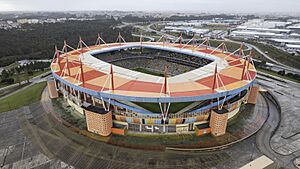
Sport Clube Beira-Mar is a local association football (soccer) club. It was founded in 1922 and has a sports academy for young players in various sports, including basketball and futsal. The club used to play at the Estádio Municipal de Aveiro. This stadium was designed for the Euro 2004 football tournament, where it hosted two matches.
Another old club in the city is Os Galitos, founded in 1904. It offers many different sports. Its rowers have even represented Portugal in international competitions, including the Olympic Games.
Notable People from Aveiro
- Fernão de Oliveira (1507 – around 1581) – A Portuguese scholar, historian, and expert on naval warfare.
- Antónia Rodrigues (1580–1641) – A Portuguese soldier and national hero.
- Jean Hyacinthe de Magellan (1722–1790) – A Portuguese scientist and philosopher.
- José Luciano de Castro (1834 in Oliveirinha – 1914) – A politician who was Prime Minister of Portugal three times.
- Jaime de Magalhães Lima (1859–1936) – A Portuguese philosopher, poet, and writer.
- Mário Sacramento (1920–1969) – A doctor and writer known for his activities against the old government.
- José Afonso (1929–1987) – Also known as Zeca Afonso, he was a very important folk and political musician in Portugal.
- Rosa Alice Branco (born 1950 in Aveiro) – A Portuguese poet.
Sports People
- Arnaldo Edi Lopes da Silva (born 1982) – Known as Edinho, a Portuguese footballer who played in almost 500 club matches.
- Diogo Valente (born 1984) – A Portuguese footballer with over 360 club matches.
- Rui Raínho (born 1989) – A Portuguese footballer with over 330 club matches.
Gallery
See also
 In Spanish: Aveiro para niños
In Spanish: Aveiro para niños


